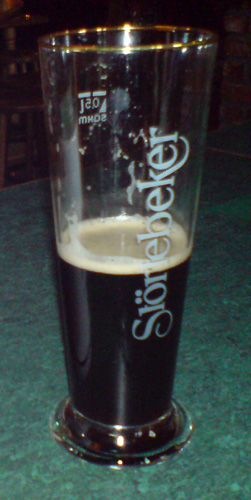
Right now I am having a Störtebeker Schwarzbier. The schwarzbier style is traditional German beer that got kind of imprisoned behind the iron curtain but has had its profile raised a little since the end of that. It is sort of a black lager. Not exactly a stout, but something headed in that direction.
To me, what it tastes like is an "old" beer. For what I mean by this, a little history. When the British first came to Australia, Australians attempted to make traditional cask conditioned ale in Australia. People who enjoy real ale know that this kind of beer is not very stable: it needs to be kept at the correct temperature and properly looked after before being drank. I enjoy a real ale more than the next guy, and I know that the experience of a "bad pint" is unfortunately too common. This style of beer making didn't work in Australia, because the climate was too hot and the beer would go off before being consumed. Thus by the end of the nineteenth century, beer made in Australia had evolved, and a black lager like beer is essentially what it had evolved into.
Around the turn of last century, proper lager making was introduced into Australia (by, amongst other people, the Foster brothers from the US) and this became the bulk of the Australian beer market. Lagers became known as "new" beer, and the traditional dark beers as "old" beer. Old beers were (and are) top fermented, and new beers bottom fermented. (This refers to the position of the yeast when the beer is being brewed. For a top fermented beer the yeast is at the top, and for a bottom fermented beer it is at the bottom.
The most common old beer that is still available is "Toohey's Old", which is still available on tap in most pubs in Sydney and the state of New South Wales. "Toohey's New" is the most popular lager in NSW. Toohey's traditional Sydney rival was Tooth's, which made similar beers, but its beers labels were disparaged after Tooth's was bought by Castlemaine of Victoria, when that brewery turned its Melbourne brands (Foster's and VB) into national brands. Old beers other than Toohey's still exist, but they are minority boutique brands these days.
However, when foreign beer experts come to Australia, the always really like Toohey's old. It is massively overrepresented in guides that talk about "Great beers of the world". Certainly it is the only beer in Australia produced by a mass market brewery that regularly manages it. I rather like it.
And German schwarzbier tastes very similar. The history is completely different, so I suspect this is an accident. (I think both the Germans and Australians would see these as old fashioned working class beers though).
Hmm. Wikipedia tells me that schwarzbier is now bottom fermented but is these days top fermented. If I were one of those people who worries about products being "authentic", perhaps the Australians do better than the Germans.
3 comments:
Bavarian dark beer is, I'm pretty sure but can't be bothered to move from the armchair to the reference book right now, a normal bottom fermented lager, just made with darker malt than normal Bavarian Helles. Some of it is very nice.
I don't know if traditional East German Schwarzbier (no Umluat in this case) is the same. Köstritzer is the only one that seems to get regularly exported to foreign countries like Bavaria.
Carlton United Breweries (CUB) bought Tooths, not Castlemaine Perkins (Queensland based brewers of XXXX now owned by Lion Nathan, the same as Tooheys).
Er, yes, I knew that. I typed "Ca.." and then seemingly completed the wrong word. I am glad I typed "of Victoria" and then talked about Carlton's national brands, because that indicates that I indeed just made a silly error. (Or alternately it indicates that I know nothing whatsoever about what I am talking. Take your pick).
It's interesting that when Australia's brewers got bought by two conglomerates they choose different branding strategy. The Lion Nathan side kept the local brands. CUB/Fosters turned its Melbourne brands into national brands. Maybe it was that the local brands on the Lion Nathan side (Swan and West End as well as Castlemaine and Tooheys) were stronger, or maybe it was the nature of the relationships between Australians cities. (Queenslanders want to contine drinking a "local" beer, and it is would probably be difficult to sell a "Sydney" beer in Melbourne).
Post a Comment